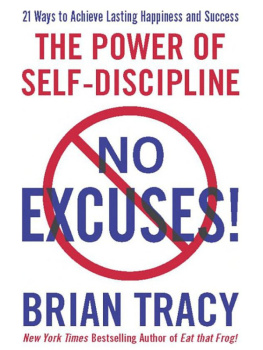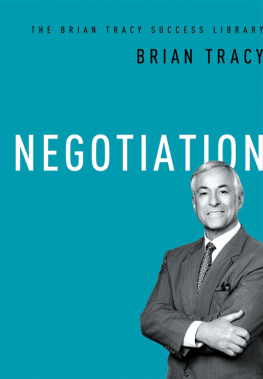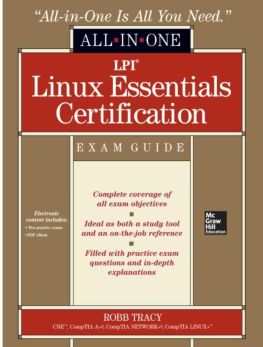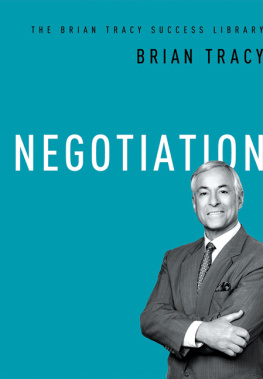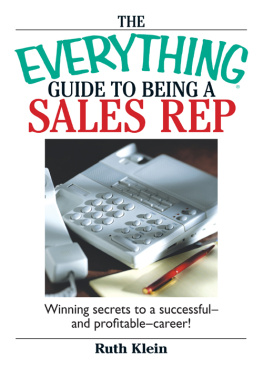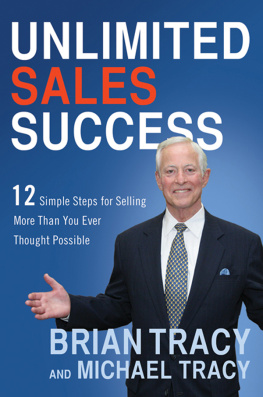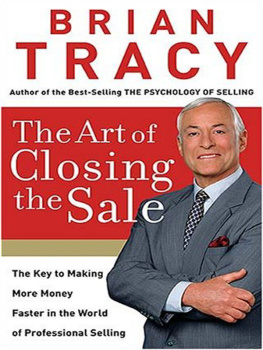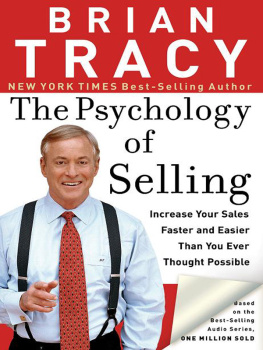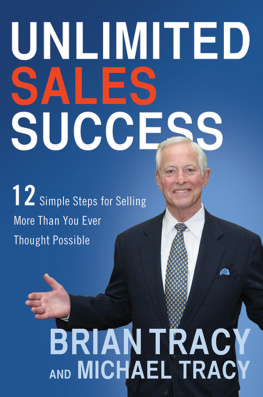SALES SUCCESS
SALES SUCCESS
BRIANTRACY

Bulk discounts available. For details visit:
www.amacombooks.org/go/specialsales
Or contact special sales:
Phone: 800-250-5308 / E-mail:
View all the AMACOM titles at: www.amacombooks.org
This publication is designed to provide accurate and authoritative information in regard to the subject matter covered. It is sold with the understanding that the publisher is not engaged in rendering legal, accounting, or other professional service. If legal advice or other expert assistance is required, the services of a competent professional person should be sought.
Library of Congress Cataloging-in-Publication Data
Tracy, Brian.
Sales success / Brian Tracy.
pages cm
Includes index.
ISBN 978-0-8144-4919-6 (hardcover) ISBN 0-8144-4919-0 (hardcover) ISBN 978-0-8144-4920-2 (ebook) 1. Selling. 2. Success in business. I. Title. HF5438.25.T7136 2015 658.85dc23
2014033825
2015 Brian Tracy
All rights reserved.
Printed in the United States of America.
This publication may not be reproduced, stored in a retrieval system, or transmitted in whole or in part, in any form or by any means, electronic, mechanical, photocopying, recording, or otherwise, without the prior written permission of AMACOM, a division of American Management Association, 1601 Broadway, New York, NY 10019.
About AMA
American Management Association (www.amanet.org) is a world leader in talent development, advancing the skills of individuals to drive business success. Our mission is to support the goals of individuals and organizations through a complete range of products and services, including classroom and virtual seminars, webcasts, webinars, podcasts, conferences, corporate and government solutions, business books, and research. AMAs approach to improving performance combines experiential learninglearning through doingwith opportunities for ongoing professional growth at every step of ones career journey.
Printing number
10 9 8 7 6 5 4 3 2 1
CONTENTS
Introduction
I have been in sales since I was 10 years old, when I began selling Rosamel beauty soap to earn my way to YMCA camp that summer. Ever since then, I have been studying, reading books, and trying to learn more about selling because I wanted to be successful at it, just as you do.
Early in my career, I began asking, Why is it that some salespeople are more successful than others?
Why is it that some salespeople earn more money, faster and easier, and make more sales? Why do they enjoy greater success, acquire better material benefits, such as cars, homes, and beautiful clothes, and achieve greater satisfaction from their careers while the great majority of salespeople underachieve and underperform?
The First Principle
Then I discovered the famous 80/20 rule known as the Pareto principle. This rule says that 80 percent of the sales are made by 20 percent of the salespeople. This means 20 percent of the sales are therefore made by 80 percent of the salespeople. When I learned this principle, I made a decision: I was going to do whatever I had to do to get into the top 20 percent. And I did.
Some years ago, a major insurance company with thousands of agents decided to test out the validity of the 80/20 rule in terms of its income and sales. The company subsequently ran all of its agents sales and income data through a computer and found that this rule held true. Twenty percent of the agents were generating 80 percent of the business. Company managers then asked what this meant in terms of annual income. They found that the top 20 percent of the agents were earning, on average, sixteen times what the bottom 80 percent were earning. Did this means that the top 20 percent were sixteen times better, smarter, or more competent than those in the bottom 80 percent?
The answer is obvious: No one is sixteen times better or smarter than someone else. Some people are just a little better in certain ways, consistently, over time.
The Top 20 Percent of the Top 20 Percent
They also looked at the top 4 percent of their agents (the top 20 percent of the top 20 percent) and compared their earnings to agents in the bottom 80 percent of sales and income. It turned out that the top 4 percent of agents were earning, on average, thirty-two times that of those in the bottom 80 percent. Taking this one step further, they compared the top 0.8 percent of agents (the top 20 percent of the top 4 percent) and found that this elite group was making, on average, more than fifty times the income of the people in the bottom 80 percent.
In every city or large office there was one person, by himself, who was earning as much as (or more than) fifty full-time adults selling the same products to the same people at the same prices, under the same competitive conditions and out of the same office.When the average salesperson, especially in all-commission fields, is earning $30,000 to $40,000 per year, the top 10 percent in those fields earn more than $800,000 per year, and some of them earn in the millions.
Make a Decision
Because of this incredible disparity in sales and income, the aim of every salesperson in every field should be to join the top 20 percent in that industry. The top 20 percent always sell well and make an exceptional living, no matter what the current market conditions. They are always employed and always in demand, and they enjoy their work the most.
Why is it that there are such enormous disparities in sales performance? In Sales Success, I will share with you some of the answers that have been discovered.
Develop the Winning Edge
One of the most important discoveries in human performance in the twentieth century was that the top performers in every field, including the field of sales, are only a little bit better that their peers in certain critical areas.
This small difference in performance is called the winning edge. The top people in each field have developed the winning edges in those fields, and, as a result, they achieve extraordinary performance and extraordinary results.
My favorite analogy is that of a horse race. In a horse race, the horse that comes in first, by a nose, wins ten times the prize money of the horse that comes in second, by a nose. Is the horse that comes in first by a nose ten times better or faster than the horse that comes in second? Is the horse that wins 10 percent faster than the horse that loses? And the answer is no. The horse that wins is only a nose faster. In a photo finish, this can be as little as three inches.
The salesperson that closes the sale for his or her company gets 100 percent of the business and 100 percent of the commission. Is the salesperson who gets the sale twice as good as the salesperson who did not make the sale? In every case, the differences between the highest performers and the lowest performers are very small, marginal edges in skill and ability.
The person who earns $250,000 a year in sales is not ten times smarter or better, or working ten times harder than the person who earns $25,000 per year, selling the same product.
Intelligence Is Not the Key
In a study in New York some years ago, researchers selected 1,000 adults at random and measured their IQs. They found that the difference between the person with the highest IQ and the person with the lowest IQ was two and a half times. But the person earning the most in this groupwhich was not necessarily the person with the highest IQwas earning more than 100 times more than the lowest earner in this sample group. The conclusion is simple: It is not raw talent or ability that accounts for great success. Everyone has natural sales talents and abilities. Your success is determined solely by what you do with those natural talents and abilities.


